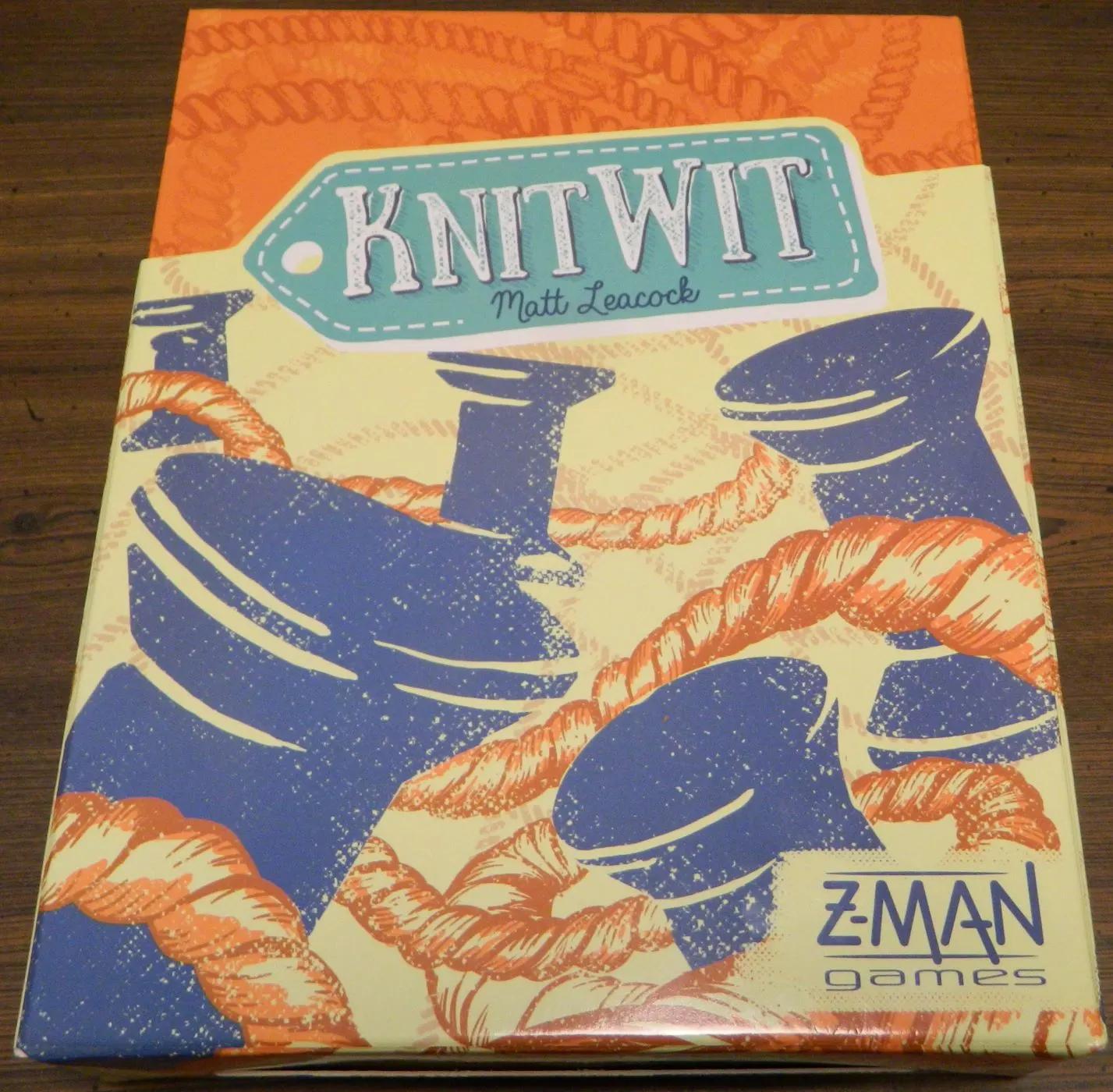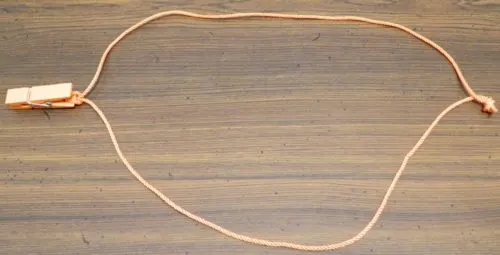For most people Matt Leacock is most known for the Pandemic and the Forbidden Island/Desert franchises. While we have only reviewed one of Matt Leacock’s games here on Geeky Hobbies (Forbidden Island) I think he is a good board game designer as I really enjoyed Pandemic despite never reviewing it here. Matt Leacock has created several other board games that are quite popular. Today I am looking at Knit Wit which is a well regarded game even if it never reached the levels of his more popular games. When I first saw Knit Wit I was intrigued because it utilized strings to add a knitting theme to a word game two things I never thought would be combined. Combining a knitting theme with a word game should not have worked but Knit Wit succeeds at being a fun twist on your typical Scattergories gameplay.
How to Play Knit Wit
Setup
- Each player takes an answer sheet and a pencil.
- Depending on the number of players each player will also take a number of loops and spools.
- 2 players – 3 loops and spools
- 3-4 players – 2 loops and spools
- 5-8 players – 1 loop and spool
- Place buttons in the center of the table based on the number of players:
- 2 players – 2 button
- 3 players – 2 and 1 button
- 4 players – 3, 2, and 1 button
- 5-8 players – 4, 3, 2, and 1 button
- Place the box of cards in the middle of the table.
- Each player writes their name on their answer sheet and crosses off any numbers corresponding to the spools that aren’t being used.
- The player with the lowest numbered spool will start the game.
Knit
Each game of Knit Wit begins with the knitting phase. In the knitting phase players will take turns starting with the first player.
Each player begins their turn by placing one of their loops on the table. When placing the loop it must enclose exactly one spool and it cannot enclose any of the other clothespins that are already on the table. As there are no spools on the table for the first player’s turn they will just place the loop on the table.
The player will then choose a card from the front of the box and clip it into the clothespin attached to the loop that they just placed. This word will be associated with the corresponding loop for the rest of the game.
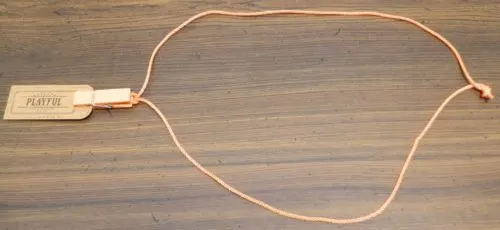
The word “Playful” has been added to the orange string. Playful will have to apply to all of the spools placed within the orange string.
Finally the current player will place one of their spools inside one or more loops that have already been played to the table. The spool does not have to be in the loop that the player just placed. The player may not place the spool into a region of the design that already has a spool.
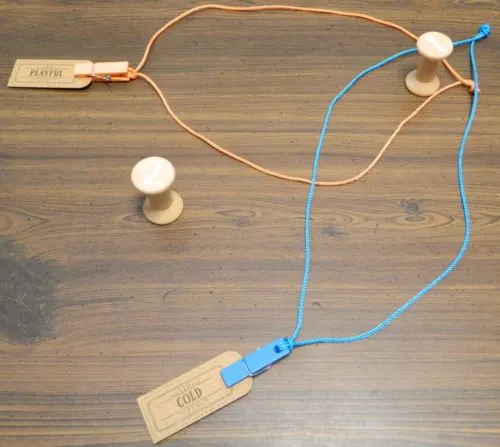
It is time for the second player to add their spool. They can place it within the orange string to the left of the blue string or they can place it within the blue string below the orange string.
After taking these three actions play will pass to the next player clockwise. Players will keep taking turns until all of the loops and spools have been played to the table.
Answer
After all of the loops and spools have been played the game passes to answer phase. When everyone is ready the first player will call out “Go” and the phase immediately begins.
During this phase the players are trying to figure out answers to write down on their answer sheet for each spool. In the knit phase the players placed spools and loops on the table. Each spool on the table corresponds to the same number on the answer sheets.
During this phase the players will look at each of the spools and the loops that are surrounding it. The players will try to come up with something that matches all of the words on the loops that surround a spool. Players can be as creative as they want as long as players agree before the game how creative of answers will be accepted. There are two rules that you must follow though:
- Players cannot just repeat one of the words/characteristics in their answer. For example if the characteristics are green and nutritious you cannot say green apple as you are repeating the word green.
- You may not use the same answer for two of the spools in the same game.
When a player comes up with an answer they will write it down next to the corresponding number on their answer sheet. They will then move onto another spool.
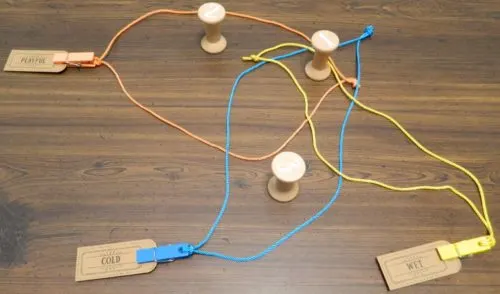
For spool #1 the players have to some up with something that is playful, cold and wet. One potential answer that fits all three characteristics is a snowball fight.
When a player has come up with an answer to all of the spools or can’t come up with an answer for the remaining spools they will take the button with the most holes from the center of the table. After a player takes a button they can no longer write anything on their answer sheet. The phase will end once all of the buttons have been taken.
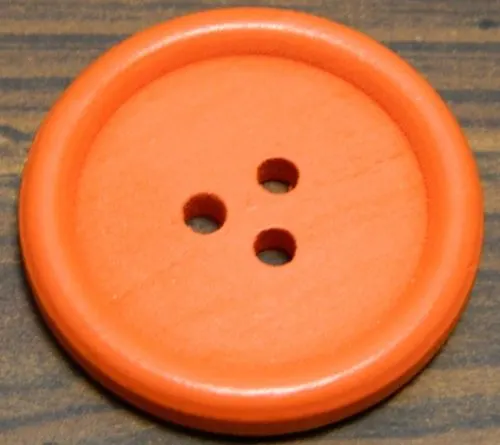
This player has finished writing down their answers. They took this button which will be worth three points at the end of the game.
Score
During the scoring phase players will compare their answers for each spool individually. If two or more players wrote down the same answer all of the players who wrote down the same answer will score zero points for the answer. Any player that wrote down their own unique answer will score points equal to the number of loops around the spool. If any of the players don’t think the answer should count they can challenge it. The challenged player has ten seconds to defend their answer. All of the players (including the challenged and challenging player) will vote on whether it should count. If half or more of the players agree that the answer should count it will score points.
Players will also score points based on the button they took. You will score one point for each hole in the button.
All of the players will compare their total scores. The player who scores the most points will win the game. If there is a tie all of the tied players will share the victory.
Two Player Game
The two player game is played the same as the normal game except there will only be one button in play during the answer phase. When one of the players takes the button the other player can write down one more answer before play moves to the scoring phase.
My Thoughts on Knit Wit
Heading into Knit Wit I didn’t really know what to expect from the game. How exactly do you combine a knitting theme with a word game? Well it turns out that you create a game that closely mimics Scattergories. In Knit Wit players will take turns adding loops and spools to the table. These end up creating an interconnected web of strings which looks a lot like a Venn Diagram. After all of the strings and spools have been placed on the table the real game begins. Players will have to come up with an answer for each of the spools which works with all of the descriptors connected to the strings that surround the spool. Like Scattergories you are trying to come up with unique answers as any answer that two or more players come up with is worth zero points. The player that is able to score the most points by coming up with the most valid answers wins the game.
While the comparison is not perfect, I keep coming back to Scattergories when I think about Knit Wit. The two games differ in some ways but at their core the two games are very similar. In both games you are trying to come up with answers that fit various categories. The catch is that you don’t want to come up with an answer that is so obvious that another player comes up with it as you then won’t score any points. Scattergories may not be a perfect game but I have always enjoyed it as it is a good party game. Knit Wit fits into a similar category and probably slightly surpasses Scattergories. I still think Scattergories has its own place in a board game collection, but I will probably end up playing Knit Wit more often.
I think this is mostly due to the premise of having to come up with answers that fit several different categories at a time. In Scattergories you are given a list of different categories and a letter. You then need to come up with an answer for each category that begins with the chosen letter. This is fun in its own right but I just found Knit Wit to be more challenging to come up with valid answers. For example you may have to come up with something that is fluffy, green and smaller than a breadbox. This requires more creativity and relies less on having a strong vocabulary as you don’t need a word that starts with a specific letter. Coming up with valid answers is satisfying especially when you come up with an answer that works with three or four different characteristics. I ultimately had a lot of fun playing Knit Wit.
Like Scattergories and most family/party word games Knit Wit is a game that the whole family should be able to enjoy. The game has an age recommendation of 8+ which I agree with mostly because children younger than that probably won’t have a large enough vocabulary to do well in the game. Otherwise I would say children even younger could play the game. The rules for the game are quite simple. The only part that may be slightly challenging is the knitting phase. Players that have troubles with this phase should adapt pretty quickly. Ultimately I think you can teach the game to new players within a couple minutes and after a round no one should have any troubles.
I usually take a board game’s components for granted as they don’t usually make or break a game for me. In the case of Knit Wit though they are hard to ignore. While the knitting theme doesn’t play much of a role in the gameplay it definitely does in the components. I found the game’s components to be fantastic. I have seen few games that have done a better job utilizing the components to reinforce a board game’s theme. Knit Wit doesn’t just do this with the artwork. Knit Wit could have easily just used the cards and had players place them into different groups. Instead you place pieces of string and spools to determine the various groups of descriptors that you have to come up with answers for. The game also uses buttons as bonus tokens with the number of holes determining how many points they are worth. Even the packaging and instructions reinforce the theme. The components add a decent amount of setup time to the knitting phase. I think it is worth it though because playing Knit Wit is such a unique experience.
Knit Wit is a good game but it does have a couple problems.
I would say that the biggest problem with the game is that it is just too short. One round is way too short which leads to problems for the game. The main problem is that one round doesn’t give players much time to distinguish themselves from the other players. Scores are very close if you play just one round where if only one player is able to come up with a valid response to a high point spool they are basically guaranteed to win the game. Finishing quickly is also really important as most games are only decided by a couple points. This ultimately leads to the game feeling like it relies on more luck than it should. The easy solution is to just play a couple rounds and combine scores from all of the rounds. Unless you lack the time I see no reason why you wouldn’t do this. This does mean that the game will likely take longer than the estimated length of 15 minutes though.
Another issue has to deal with the fact that it seems to be pretty easy to come up with answers that will score you points. This issue should be lessened with more players but at least with four players it can be a potentially big problem. I think this is mostly due to the fact that the descriptors are vague enough that there are many different potential answers. Unless two players are on the same wavelength they likely will come up with different valid answers that will both score points. You will likely score points for almost every spool which means the one player that is able to come up with an answer to a spool that none of the other players can will likely win the game. This can somewhat be reduced by placing more loops around the spools as your answers will need to fit more criteria. It usually is still not hard to come up with an answer though unless you have at least three loops around a spool.
This won’t be a problem for everyone but some players will occasionally have troubles figuring out what color loops surround a spool. Most of the time it is pretty easy to tell which descriptors relate to a spool but there will be times where players will struggle to figure it out. Normally players would be able to help one another figure it out. The problem is that Knit Wit is a speed game so players have to be focused on writing down their own answers instead of helping the other players. Therefore you need to play the game on a table where all of the players can see all of the cards themselves as they won’t have the ability to ask the other players for help.
Like a lot of these type of board games there is a very real potential for players to fight over what answers should count and which shouldn’t. The game does provide mechanics to mitigate this. Players whose answers are challenged can defend their answer and players will then vote on whether it should count. This mitigates the problem some but there could still be arguments over what should and shouldn’t count. Players can agree to how “creative” of an answer they will accept before the game begins, but there are likely to be some players that will try to stretch that limit as much as they can. If you have two or more competitive players that stretch the limits on valid answers they will likely argue over what should and shouldn’t count. While there is no way to fully get rid of these problems the best solution is for players to not take the game too seriously. Knit Wit is best when players are just trying to have fun instead of obsessing over trying to win.
Should You Buy Knit Wit?
Despite sharing mechanics similar to Scattergories and adding a knitting theme to a word game, Knit Wit still succeeds for the most part. I think this is mostly because the game is simple and to the point. The game at its core is a family/party word game where the players try to come up with answers that fit a number of different characteristics. This is similar to Scattergories and yet Knit Wit still distinguishes itself to make for a fun word game that the whole family can enjoy. What really differentiates the game is the components/theme. While it adds a little time to the game there is something that is really satisfying about weaving the loops and spools to basically create the most complicated Venn Diagram ever created. When you add in the fantastic components the game does a great job utilizing the knitting theme. I had a lot of fun with Knit Wit but it does have some problems. The game is too short where you are best off playing several rounds especially since it is sometimes too easy to come up with valid answers. Potentially the biggest problem though is that competitive players are likely going to argue over what answers should count and which shouldn’t.
If you have never been a big fan of word games in general or Scattergories in particular Knit Wit is probably not going to be for you as it shares a lot in common with these other games. Fans of word games or Scattergories should really enjoy their time with Knit Wit as it is a fun little twist on the typical formula. If that describes you I would highly recommend checking out Knit Wit.

